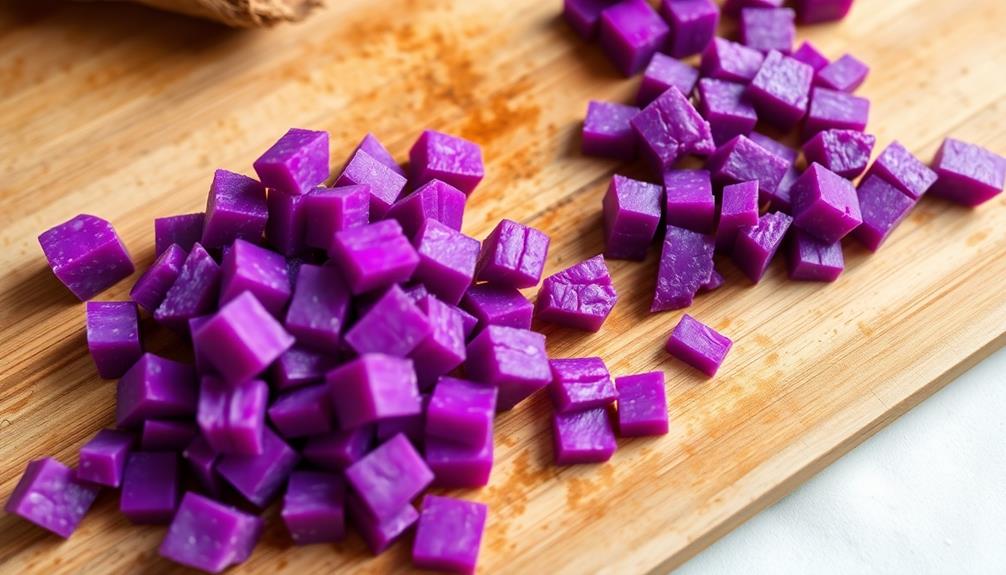You haven't lived until you've tried ube, the vibrant purple yam from the Philippines! This versatile ingredient has captured the hearts of dessert lovers worldwide. For centuries, ube has been a staple in Filipino cuisine, used in sweet and savory dishes. Its mild, nutty sweetness makes it a perfect addition to cakes, ice cream, and even smoothies. Plus, it's packed with vitamins and fiber, so you can indulge guilt-free. Whether you're looking to add a pop of color to your baking or explore new flavors, ube is sure to delight. Keep reading to learn more about this captivating culinary treasure.
Key Takeaways
- Ube, the vibrant purple yam, has gained global popularity for its use in visually appealing and flavorful desserts, showcasing its versatility in culinary creations.
- Originating from the Philippines, ube holds deep cultural significance and has been a staple ingredient in Filipino cuisine for centuries, featured in both sweet and savory dishes.
- Ube's natural sweetness, mild nutty flavor, and striking purple color make it a desirable ingredient for a range of desserts, from ice cream to cakes and pastries.
- The growing availability and recognition of ube in international markets have led to its increasing incorporation in innovative fusion cuisines and the rising demand for ube-based products worldwide.
- Proper preparation techniques, such as boiling or steaming, are essential to unlock ube's full flavor and vibrant color, ensuring its successful integration into a variety of sweet and creative culinary applications.
History
Although the origins of ube can be traced back to the tropical regions of Asia, it was in the Philippines where this vibrant purple yam truly found its home. Ube has been a staple ingredient in Filipino cuisine for centuries, used in everything from sweet desserts to savory dishes.
The name "ube" comes from the Tagalog word for the tuber, which has been cultivated in the Philippines since pre-colonial times. Ube was especially important in the indigenous Igorot culture, where it was considered a sacred plant and often used in religious ceremonies.
Today, ube remains an integral part of Filipino culture and identity. It's widely grown throughout the archipelago and has even become a popular export, with ube-flavored products finding their way onto the shelves of grocery stores and bakeries around the world.
Whether you're enjoying a creamy ube halaya or a vibrant ube cheesecake, this humble purple yam continues to captivate the hearts and palates of food lovers everywhere.
Recipe
Ube, the vibrant purple yam, is a beloved ingredient in various Filipino dishes. Its striking color and distinctive sweet flavor make it a versatile ingredient that can elevate both savory and sweet creations.
Ube's unique properties lend themselves well to a variety of cooking techniques, allowing for endless culinary possibilities. One such delightful dish that showcases the beauty of ube is a simple yet satisfying ube recipe. This recipe captures the essence of the purple yam, highlighting its natural sweetness and creamy texture.
- 1 lb ube, peeled and cubed
- 1 cup coconut milk
- 1/2 cup white sugar
- 1/4 tsp salt
In a medium saucepan, combine the cubed ube, coconut milk, sugar, and salt. Bring the mixture to a boil over medium heat, stirring occasionally. Reduce the heat to low and simmer for 20-25 minutes, or until the ube is tender and the mixture has thickened.
Mash the ube lightly with a fork or potato masher, leaving some chunks for texture. Serve warm or chilled, as desired.
When preparing this ube dish, it's important to use fresh, high-quality ube. The color and flavor can vary depending on the variety, so feel free to experiment and find the one that best suits your taste.
Additionally, adjusting the sugar content can help balance the natural sweetness of the ube to your personal preference.
Cooking Steps
Peel the ube and chop it into bite-sized cubes.
Boil the cubes until they're nice and tender.
Grab a fork and mash the boiled ube into a smooth, creamy texture.
Now, stir in some sugar and milk for a delightful touch of sweetness.
Pop it in the fridge until it's completely cooled – you'll have a delectable ube treat in no time!
Step 1. Peel and Chop Ube Into Cubes

Careful preparation is the key to unlocking the full potential of this versatile root vegetable. Start by thoroughly rinsing the ube under cool running water.
Use a sharp knife to carefully slice off both ends, then stand the ube upright on a cutting board. Gently peel away the thick, rough skin, revealing the vibrant purple flesh underneath.
Once peeled, slice the ube into even, bite-sized cubes, about 1-inch in size. This step ensures the ube cooks evenly, allowing the natural sweetness and creamy texture to shine.
As you work, be mindful of your fingers – the ube's skin can be surprisingly tough. Take your time and use caution to avoid any nicks or cuts.
With the ube prepped and ready, you're one step closer to creating a delightful, eye-catching dish that'll have your friends and family reaching for seconds.
Step 2. Boil Ube Until Tender

Next, you'll want to bring a pot of water to a boil. Once the water is boiling, carefully add the prepared ube cubes.
You'll need to let the ube simmer for about 15-20 minutes, or until the pieces are tender when you poke them with a fork. Be sure to keep an eye on the pot, as you don't want the ube to overcook and become mushy.
As the ube boils, you'll notice the water turning a deep, vibrant purple. This is the ube's natural color shining through!
Once the ube is tender, drain the pot and set the cooked ube pieces aside. They're now ready to be mashed, baked, or used in your favorite ube-based dessert recipes.
The boiling process helps soften the ube, making it easier to work with in the next steps of your culinary creation. Get ready to enjoy the delightful, sweet flavor and stunning purple hue of this versatile ingredient!
Step 3. Mash Boiled Ube Until Smooth

With the boiled ube cubes now tender and ready, you can mash them until they're smooth and creamy. Using a potato masher or a sturdy fork, gently press down on the ube pieces, mashing them into a thick, uniform paste.
Don't worry if a few small chunks remain – this will add a lovely, rustic texture to your ube puree. As you mash, you'll notice the vibrant purple hue of the ube come to life. The more you work the ube, the smoother and creamier the texture will become.
Keep mashing until you achieve the desired consistency, whether you prefer a silky-smooth puree or a slightly chunky mash.
Once mashed, your ube is now ready to be used in a variety of delectable desserts, from rich ube halaya to fluffy ube-flavored cakes and pies. The possibilities are endless!
With your ube now prepped, you can let your culinary creativity shine.
Step 4. Add Sugar and Milk

After mashing the ube until smooth, you'll want to add some sugar and milk to enhance the flavor and create a creamy texture.
The sugar will balance the natural sweetness of the ube, while the milk will give it a rich, velvety consistency.
Start by adding a few tablespoons of sugar, tasting as you go until you reach the desired level of sweetness.
Then, slowly pour in some milk, stirring constantly, until the mixture reaches your preferred creaminess.
You might need to add a bit more milk if the ube becomes too thick.
The key is to keep tasting and adjusting the ingredients until you've achieved the perfect balance of sweet and creamy.
Once you're satisfied, you can use this ube mash as the base for all sorts of delicious desserts, from tarts and cakes to ice cream and custards.
Get ready to wow your friends and family with your homemade ube creations!
Step 5. Refrigerate Until Completely Cooled

Once the ube mash is blended with the sugar and milk, refrigerate the mixture until it's completely cooled. This chilling process is crucial for achieving the desired texture and flavor.
As the ube cools, the sugars and milk will meld together, creating a rich, creamy consistency. Be patient and let the mixture sit in the fridge for at least an hour, or until it's completely set.
You'll know it's ready when you gently touch the surface, and it feels firm and smooth. Resist the temptation to dig in too soon – the waiting will be worth it!
Once the ube is fully chilled, it's time to scoop and serve. You can enjoy it as is, or get creative by layering it with other fillings or toppings.
The cool, velvety ube pairs beautifully with fresh fruit, nuts, or a drizzle of caramel. Experiment and find your favorite flavor combinations. The possibilities are endless when you've got this vibrant, versatile ingredient on hand.
Final Thoughts
Ube, the vibrant purple yam, has undoubtedly captivated the hearts and palates of food enthusiasts worldwide. From its mesmerizing hue to its unique, sweet flavor, this versatile ingredient has become a staple in desserts and delicacies across the globe.
Whether you're whipping up a batch of creamy ube ice cream, baking ube-infused pastries, or simply enjoying the yam in its natural form, the possibilities are endless.
As you continue to explore the wonders of ube, remember to embrace its vibrant charm and savor each delectable bite. This remarkable ingredient is sure to spark joy and delight in your culinary adventures.
Frequently Asked Questions
How Long Can Ube Last Before It Spoils?
Ube can last up to 5 days at room temperature before it spoils. If you refrigerate it, it'll stay fresh for up to a week. But don't let it sit too long – it'll quickly turn soft and mushy.
Is Ube Safe for People With Diabetes?
While ube is generally safe for people with diabetes, it's important to monitor your blood sugar levels carefully. The natural sugars in ube can still impact your diabetes management, so be mindful of portion sizes and consult your healthcare provider.
Can Ube Be Used in Savory Dishes?
You can absolutely use ube in savory dishes! Its natural sweetness and vibrant color can add depth and visual appeal to a variety of savory recipes, from curries to rice dishes and beyond. Get creative with this versatile ingredient.
How Does Ube Compare to Other Purple Produce?
Compared to other purple produce, ube has a distinct sweet, nutty flavor that sets it apart. While purple potatoes or carrots offer earthy notes, ube's unique profile makes it a versatile ingredient in both sweet and savory dishes.
Where Can I Purchase High-Quality Ube Online?
You can purchase high-quality ube online from specialty Asian grocery stores or directly from reputable ube farms. Look for suppliers that offer fresh, vibrant ube with a deep purple hue and smooth texture.









